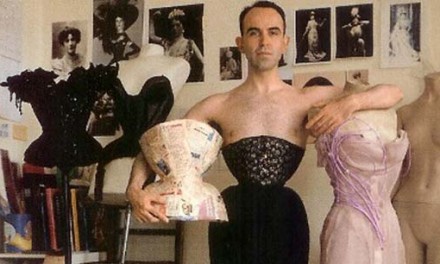I walked into a room, and my breath was taken from me. Not figuratively. I mean it. The air shifted. My chest tightened. My eyes didn’t know where to land. Gold everywhere. Not gaudy. Not showy. Sacred.
I was standing inside what felt like a Renaissance dream turned fashion sanctuary. Imagine: golden palazzo frames, many in one room, each more extravagant than the last. Chandelier after chandelier swaying gently from vaulted ceilings, all made from Venetian Murano glass. The kind that sparkles like dew under candlelight. But these weren’t chandeliers you’d find in a dining room.
The billionaire world of opulence.

They were dresses.
Yes. Entire gowns shaped like chandeliers—lit from within, glowing with the spirit of Italy, the craft of Venice, the obsession of Dolce & Gabbana. You don’t wear these dresses. You worship them. You witness them. You stare in awe because deep down, you know, this is a lost art.

From the Heart to the Hands
The exhibition in Rome—From the Heart to the Hands—is not a fashion show. It’s a cathedral of couture. It’s a confession booth for those of us who still believe clothing can touch the soul.
These aren’t just garments. These are relics. They are the Sistine Chapel in silk and beading. Each frame, each dress, each stitch—handmade. Crafted by artisans who live for beauty, not mass production. Fashion from the hands, guided by the heart. You don’t find this in Paris anymore. You don’t find this in New York. Not like this. Not at this level of madness and precision.
This is Italian.

Murano Dreams and Gilded Reality
Murano glass is not just decorative. It is tradition. It is legacy. And the D&G boys took it and spun it into gowns. Dresses so delicate, so elaborate, they shimmered like the chandeliers above them. Crystal droplets dangled from bodices. Skirts cascaded in translucent gold, reflecting every light in the room like sun on the Grand Canal.
I couldn’t breathe. Not just from the beauty—but from the realization that this might be the last of it. Once Domenico and Stefano are gone, who will do this? Who will dare to create fashion this theatrical, this meticulous, this unapologetically grand?
No one.
Because fast fashion killed the artisan. Because Zara and Shein drowned the lace-makers and thread-workers in algorithms and two-day shipping. Because influencers would rather wear gym shorts than gowns.


Fashion with Soul
As I stood there, surrounded by golden frames and floating gowns, I watched people respond. They laughed in disbelief. They gasped. Some reached for their phones. Others just stared silently, mouths slightly open, as if watching an opera aria soar through a grand theatre. You don’t react like this to polyester jumpsuits or AI-generated trends. This is human-made, soul-filled art.
Each dress told a story. One gown looked like it belonged to a goddess of Sicily. Another, like a Roman empress ready to seduce the Senate. The corsetry was tight. The beading was hypnotic. Some gowns took hundreds—if not thousands—of hours to complete.
Every seam was a heartbeat. Every hem, a prayer.
I overheard someone say, “This is like something from a dream.” But it’s not. It’s real. It’s just rare. Fashion today has lost its ritual. But D&G are priests of couture. They baptise fabric in culture, in tradition, in Italian soul.

Beyond the Gown
This isn’t just about pretty dresses. It’s about a way of life. It’s about honouring what came before—generations of Italian women who wore hand-sewn lace to weddings, baptisms, funerals. It’s about remembering that fashion used to mean something.
My grandmother, Nonna Donata, now in her 80s, still keeps her handmade gowns from her youth. Gowns sewn by women who knew their craft. Who didn’t need trend reports or TikTok. They worked with hands, not hashtags. They created because it was in their blood.
D&G have taken that same philosophy and amplified it. They’ve turned it into opera. Into theatre. Into gold.

The Sacred Space
In that room, surrounded by gold palazzo frames and Venetian chandeliers, I felt like I was inside a fashion cathedral. It was spiritual. It was solemn. It was powerful.
This isn’t a place to breeze through with your gelato and iPhone. This is a place to feel. To remember. To pay your respects to an art form on the edge of extinction.
You won’t find this in Milan Fashion Week. You won’t find it at Coachella. You won’t find it on Instagram.
You’ll find it here. In Rome. In a room where light dances on Murano glass and corsets whisper stories of women who once ruled the world in silence.
A Future Without Hands
The saddest truth about this exhibition is that it feels like a goodbye.
Once Domenico Dolce and Stefano Gabbana are gone—who will carry this torch? Who will spend 1,000 hours on one dress? Who will train a team of seamstresses to hand-embroider Sicilian stories into skirts? Who will insist on real Murano, not plastic?
The fashion world isn’t preparing for this loss. It’s numbing itself with trends. With filters. With AI-generated outfits that lack touch, story, humanity.
But not here. Not yet.
This exhibition is the final rebellion. A love letter to handmade beauty. A farewell sonata to fashion with soul.

Why You Must See It
If you are in Rome, make the time. I don’t care if it’s 41 degrees outside. Wear the heels. Bring the fan. Arrive melting. This is worth every step.
You will not regret it. You will remember it forever.
Watch the video. Look at the gowns. See the chandeliers. Stand in that golden room and feel what I felt: breathless awe, aching nostalgia, and deep, deep gratitude that fashion like this ever existed at all.
This isn’t a trend. This is a requiem. This is what happens when fashion has hands. When fashion has heart. When fashion has a soul.
This is Dolce & Gabbana.















You must be logged in to post a comment.